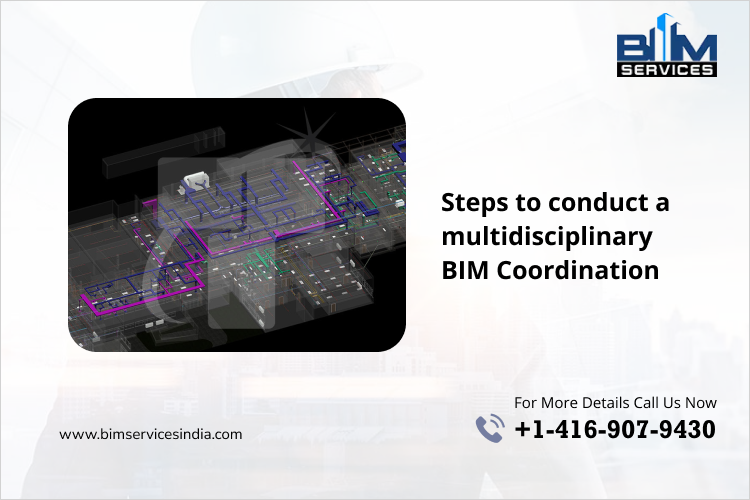Steps to conduct a multidisciplinary BIM Coordination

BIM Coordination Services plays a crucial role in the construction process as it helps in improving collaboration and coordination among Architectural, Structural, and MEP disciplines. With BIM Services, the architects, modelers, and engineers can identify any 3D geometrical conflicts and resolve them offsite before the actual commencement of the project. Clash Detection removes on-site conflicts, coordination issues and saves building costs.
The construction of a building project requires collaboration and coordination of different systems and components. Clashes can arise when the various models are combined to generate the final coordinated model. Structural engineers can use BIM for generating a 3D model of a load-bearing wall. A mechanical engineer can use BIM for generating a 3D model of the HVAC system. During the coordination, it might be evident that the AC duct is running through the structural beams creating a clash. The collision can be detected and resolved using BIM Coordination Services in the design phase.
Table of Contents
Overview of Multidisciplinary BIM Coordination
A process that involves combining models of multiple disciplines such as architectural, structural, mechanical, electrical, plumbing, firefighting, prefabrication, and checks whether there are collisions between these models. It includes estimating the accuracy of the information contained in the models, sending collision reports, creating lists of model elements, and conducting coordination meetings.
Collaboration and exchange of information between architectural, structural, and MEP disciplines helps in constructing a complex and successful building structure. MEP Engineering consists of various sub-disciplines such as mechanical, electrical, plumbing and firefighting. Clash Detection Services is implemented at both intra and inter-discipline levels. It helps in identifying spatial conflicts, restraints, or sequencing issues that are shared with the responsible parties to work on a solution together.
Steps to conduct a multidisciplinary BIM Coordination
Proper Placement of Models
The first step in the multi-faceted BIM Coordination is the collaboration and placement of different models with each other. If models are not coordinated properly, two effects occur such as lack of collisions or many nonexistent collisions to check. To avoid such situations, it is advisable to combine the models in the same coordinate system and set it accurately. Using Autodesk Revit, we can coordinate the different models and resolve all the clashes.
>
Selecting BIM Coordination Tools
There are many BIM Coordination tools available in the market and choosing the ideal tool for your purpose depends on several factors such as are these models created in one or more programs, which tool currently is being used for multidisciplinary BIM coordination and any licensed program for coordination.
Programs for conducting multidisciplinary BIM coordination
Modeling program: – Using one tool for modeling multiple disciplines can be one of the options. Autodesk Revit gives the ability to check collisions and links other disciplinary models and select clash detection in the coordinated model.
CDE: – There is a possibility to conduct a collision check between models in the cloud through CDE. There are many tools available in the market but we have used some known tools such as Trimble Connect or Autodesk BIM 360 platform which helps to conduct collision checks in the CDE.
BIM Coordination tools: – Here the programs can create advanced model coordination with tools that ensure possibilities in terms of file reading, collision detection and check, model data validation, creating detection rules, etc. to all the disciplinary people involved in the project.
Exporting Models to IFC Format
During multidisciplinary coordination, building systems can use different modeling software. The different software such as ArchiCAD, Tekla, etc. is made by the different providers and saves the models to different file formats which consist of merging the model into a coordinated model that includes all tested disciplines. It is necessary to have all the files in the same format. Thus, exporting the different models to the IFC Format is the next step in coordination.
Carefully analyze the mapping of the data from the native file to the IFC file, what kind of 3D view do we use when exporting and view objects that are hidden and may not be exported to IFC.
- Combine different disciplinary models into one
After having all the models in the IFC format, there is a need to combine them into a multidisciplinary model which serves as the base for coordination.
Checking the scope of the model
It is important to define the end goal of the BIM Coordination process to further figure out if we are looking for clashes or want to figure out the information accuracy. It is necessary to figure out whether we are checking for space validation or there is proper space between the building elements.
Conclusion
Multidisciplinary coordination requires the BIM coordinator to have insight concerning several tools which might not be an easy process. Adopting the right methods can ensure that the engineering requirement of a building is successfully implemented into planned design and aesthetics.
VDC using Revit tools facilitate coordination between the design of a building and aesthetics before actual construction begins. With the right pre-construction partner for your projects, firms can avail high-quality and cost-effective BIM Modeling Services for interdisciplinary coordination from anywhere in the world where there is a large supply of qualified and experienced BIM and visual design experts.